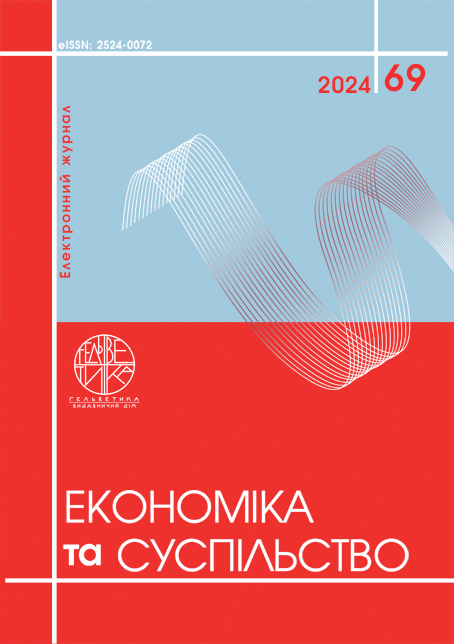THE INTEGRATION OF MIGRANTS: ESSENTIAL CHARACTERISTICS AND DIMENSIONS
Abstract
The war in Ukraine has led to a significant migration of population, mainly of employable age. Therefore, the issue of integration of Ukrainians into different spheres of social life in the recipient countries, especially into the labour market, is becoming relevant. The purpose of the article is to elaborate on the theoretical and methodological foundations and develop the essential characteristics and dimensions of migrants’ integration into different spheres of life in the recipient country. The study uses the methods of comparative analysis, critical generalisation, and categorisation. The analysis of the research on migration and the integration of migrants into different spheres of life in the recipient countries has shown that there is no common ground in the views of scholars on the essential characteristics and dimensions of the concept of integration of migrants. Based on a comparative analysis of the approaches of different researchers, the methodological principles that define the essential characteristics of the concept of integration of migrants have been formulated. It is determined that integration is a multi-vector process that involves different parties and actors and implies the reconciliation of migrants and members of the community/society. Integration is not a linear process and can take place with different intensity and in different directions, including in the opposite direction in case of loss of employment, disability, etc. For a migrant, the integration process involves becoming accepted by society, an equal member of a particular community: a group, a team, a work team, or a local community. Based on a synthesis of various approaches of scholars, the article identifies economic, professional, educational, social, language, cultural and religious, political and legal, civic and status dimensions of migrant integration, which are closely interrelated and influence each other. The problems associated with the integration of migrants and the conditions for their successful economic integration have been identified. In terms of theory, the study develops the concept of migrants’ integration into various spheres of life in the recipient country. The study results can be used to elaborate recommendations for the better employment of migrants’ human capital in recipient countries.
References
Adda J., Dustmann C., Görlach J.-S. The dynamics of return migration, human capital accumulation, and wage Assimilation. SSRN Electronic Journal. 14333. 2021. P. 1-15.
Ager A., Strang A. Understanding Integration: A Conceptual Framework. Journal of Refugee Studies. 2008. Vol. 21. № 2. P. 166191. https://doi.org/10.1093/jrs/fen016
Bommes M. Transnationalism or assimilation? In Immigration and social systems: Collected essays of Michael Bommes. IMISCOE Research. Amsterdam : Amsterdam University Press, 2012. P. 107-124.
Esser H. Integration und Etnische Schichtung. Working paper № 40. Mannheim: Mannheimer Zentrum für Europäische Sozialforschung, 2001.
Favell A. Integration and nations: the nation-state and research on immigrants in Western Europe. Comparative Social Research Multicultural Challenge. 2003. Vol. 22. P. 13-42.
Górny A., Zwan R. Mobility and labor market trajectories of Ukrainian migrants to Poland in the context of the 2014 Russian invasion of Ukraine. European Societies. (2024). https://doi.org/10.1080/14616696.2023.2298425.
Heckmann F., Schnapper D. The integration of immigrants in European Societies. Stuttgart : Lucius and Lucius, 2003. 261 p.
Hooper K., Desiderio M.V., Salant B. Improving the labour market integration of migrants and refugees. Empowering cities through better use of EU instruments. Working paper. Migration Policy Institute Europe. 2017. 42 p.
Lange T., Oomes N., Gons N., Spanikova V. Labour Migration and Labour Market Integration of Migrants in the Netherlands: Barriers and Opportunities Annex D to “Dutch labour market shortages and potential labour supply from Africa and the Middle East” (SEO Report No. 2019-24). Amsterdam, Dutch Ministry of Foreign Affairs, 2019. 58 p. URL: https://www.seo.nl/wp-content/uploads/2019/01/Annex_D_Barriers_to_Migration_and_Integration.pdf (accessed 11.12.2024).
Lindo F. The concept of integration: Theoretical concerns and practical meaning. In Social integration and mobility. Lisbon : Centro de Estudos Geográficos 2005. P. 7-20.
Maruszewski W., Kaczmarczyk P. Economic Integration and Migrant Networks: The Case of Ukrainian Migrants in the Warsaw Agglomeration. Central European Economic Journal. 2020. Vol. 7 № 54. P. 258-278. https://doi.org/10.1515/ceej-2018-0003.
Müller T., Pannatier P., Viarengo M. Labor market integration, local conditions and inequalities: Evidence from refugees in Switzerland. World Development. 2023. Vol. 170. https://doi.org/10.1016/j.worlddev.2023.106288.
Penninx R. Integration of migrants: economic, social, cultural and political dimensions. In the New Demographic Regime Population Challenges and Policy Responses. Edited by M. Macura, A. L. MacDonald, W. Haug. New York, Geneva, UN, 2005. P. 137151.
Penninx R., Garcés-Mascareñas B. The Concept of Integration as an Analytical Tool and as a Policy Concept. In Integration Processes and Policies in Europe. Contexts, Levels and Actors. Springer, 2016. P. 11-29.
Phillimore J. Implementing integration in the UK: lessons for integration, theory, policy and practice. Policy and Politics. 2012. Vol. 40. № 4. Р. 525-545.
Pineau M.G., Waters M.C. The Integration of Immigrants into American Society. Washington :The National Academies Press, 2016. 458 p.
Salaris L., Tedesco N. Migration and the Labour Market: Ukrainian Women in the Italian Care Sector. Journal of International Migration & Integration. 2020. Vol. 21. P. 1-20. https://doi.org/10.1007/s12134-019-00656-1.
Spencer S., Charsley K. Conceptualising integration: a framework for empirical research, taking marriage migration as a case study. Comparative Migration Studies. 2016. Vol. 4 № 18. P. 119.
United Nations High Commissioner for Refugees. Ukraine Refugee Situation. URL: https://data.unhcr.org/en/situations/ukraine (accessed 11.12.2024).
Adda J., Dustmann C., Görlach J.-S. (2021) The dynamics of return migration, human capital accumulation, and wage Assimilation. SSRN Electronic Journal, 14333, pp. 1-15.
Ager A., Strang A. (2008) Understanding Integration: A Conceptual Framework. Journal of Refugee Studies, vol. 21(2), pp. 166191. https://doi.org/10.1093/jrs/fen016.
Bommes M. (2012) Transnationalism or assimilation? In Immigration and social systems: Collected essays of Michael Bommes. IMISCOE Research. Amsterdam : Amsterdam University Press, pp. 107-124.
Esser H. (2001) Integration und Etnische Schichtung. Working paper № 40. Mannheim: Mannheimer Zentrum für Europäische Sozialforschung.
Favell A. (2003) Integration and nations: the nation-state and research on immigrants in Western Europe. Comparative Social Research Multicultural Challenge, vol. 22, pp. 13-42.
Górny A., Zwan R. (2024) Mobility and labor market trajectories of Ukrainian migrants to Poland in the context of the 2014 Russian invasion of Ukraine. European Societies. https://doi.org/10.1080/14616696.2023.2298425.
Heckmann F., Schnapper D. (2003) The integration of immigrants in European Societies. Stuttgart : Lucius and Lucius. 261 p.
Hooper K., Desiderio M. V., Salant B. (2017) Improving the labour market integration of migrants and refugees. Empowering cities through better use of EU instruments. Working paper. Migration Policy Institute Europe. 42 p.
Lange T., Oomes N., Gons N., Spanikova V. (2019) Labour Migration and Labour Market Integration of Migrants in the Netherlands: Barriers and Opportunities Annex D to “Dutch labour market shortages and potential labour supply from Africa and the Middle East” (SEO Report No. 2019-24). Amsterdam, Dutch Ministry of Foreign Affairs. 58 p. Available at: https://www.seo.nl/wp-content/uploads/2019/01/Annex_D_Barriers_to_Migration_and_Integration.pdf (accessed December 11, 2024).
Lindo F. (2005) The concept of integration: Theoretical concerns and practical meaning. In Social integration and mobility. Lisbon : Centro de Estudos Geográficos. Pp. 7-20.
Maruszewski W., Kaczmarczyk P. (2020) Economic Integration and Migrant Networks: The Case of Ukrainian Migrants in the Warsaw Agglomeration. Central European Economic Journal, vol. 7(54), pp. 258278. https://doi.org/10.1515/ceej-2018-0003.
Müller T., Pannatier P., Viarengo M. (2023) Labor market integration, local conditions and inequalities: Evidence from refugees in Switzerland. World Development, vol. 170. https://doi.org/10.1016/j.worlddev.2023.106288.
Penninx R. (2005) Integration of migrants: economic, social, cultural and political dimensions. In the New Demographic Regime Population Challenges and Policy Responses. Edited by M. Macura, A. L. MacDonald, W. Haug. New York, Geneva, UN. Pp.137-151.
Penninx R., Garcés-Mascareñas B. (2016) The Concept of Integration as an Analytical Tool and as a Policy Concept. In Integration Processes and Policies in Europe. Contexts, Levels and Actors. Springer. Pp. 11-29.
Phillimore J. (2012) Implementing integration in the UK: lessons for integration, theory, policy and practice. Policy and Politics, vol. 40(4), pp. 525-545.
Pineau M. G., Waters M. C. (2016) The Integration of Immigrants into American Society. Washington : The National Academies Press. 458 p.
Salaris L., Tedesco N. (2020) Migration and the Labour Market: Ukrainian Women in the Italian Care Sector. Journal of International Migration & Integration, vol. 21, pp. 1-20. https://doi.org/10.1007/s12134-019-00656-1.
Spencer S., Charsley K. (2016) Conceptualising integration: a framework for empirical research, taking marriage migration as a case study. Comparative Migration Studies, vol. 4(18), pp. 1-19.
United Nations High Commissioner for Refugees. Ukraine Refugee Situation. Available at: https://data.unhcr.org/en/situations/ukraine (accessed December 11, 2024).

This work is licensed under a Creative Commons Attribution 4.0 International License.


